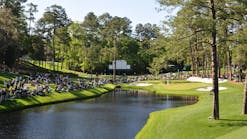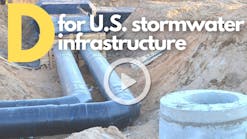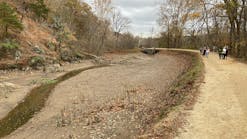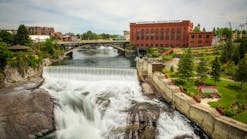What makes most urban environments attractive are all the people, places, and things flowing together to create exciting experiences. Families playing together in public parks. Couples frequenting trendy restaurants. Drivers cruising in and out of downtown hotspots. Sports fans flocking to local venues to root for the home teams. In urban settings, the flow of life is on full display.
Not so front and center is the impact these activities can have on our quality of life. Parks are manicured with fertilizers and pesticides. Restaurants dispose of food waste daily. Cars emit gasoline, motor oil, and brake fluid. Sports venues kick up contaminants before, during, and after every game. When a precipitative event like rain or snow comes along, all the urban runoff flows from our driveways, lawns, parks, streets, buildings, and other impervious surfaces into municipal storm drain structures and ultimately our waterways.
Until recently, most approaches to treating stormwater were either site-specific systems near small receiving waters or mammoth structures built to handle large watersheds. The Los Cerritos Channel Stormwater Capture Facility, for example, treats 17,771 acres of watershed across seven Southern California cities. A newer method has emerged in recent years to treat runoff earlier in the flow cycle using low impact development green infrastructure (LID/GI) designs in urban environments. Instead of detention ponds and retention basins, LID/GI aims to treat stormwater closer to pollutant sources and with smaller footprints.
Benefits of BiofiltrationBiofiltration is one of the more popular LID/GI strategies for urban stormwater capture and treatment. Combining filtration, adsorption, and biological uptake toOriginally introduced in 1893 as a trickling filter for wastewater treatment in England, biofiltration is all the buzz in the stormwater industry today. Most systems on the market offer a combination of modular design, filter media, biomass, and vegetation. The basic process is stormwater runoff flows into the system, through the media/biomass for treatment, and exits via an underdrain for infiltration, detention, or reuse. Inorganic components remove total suspended solids (TSS), metals, nutrients, oil, and grease. Organic components remove nutrients and facilitate biological uptake, which supports vegetation.
Engineers and contractors seeking biofiltration products among the many currently on the market might consider working with those that have been tested and verified by the New Jersey Corporation for Advanced Technology (NJCAT) and certified by the New Jersey Department of Environmental Protection (NJDEP). The independent two-step NJCAT/NJDEP process is a nationally recognized performance validation program for stormwater devices.
Making the Most of Media
When considering the types of biofiltration systems best suited for tackling urban runoff, one of the key differentiators is the makeup of the media. Not all media for stormwater treatment is made alike. Different materials achieve different outcomes. To reach an 80% removal rate of TSS—the standard level most regulatory agencies follow, including NJCAT/NJDEP—media manufacturers typically use a proprietary mix of vegetation, sand filter, and biosoil. The combination of these materials is important to engineers and contractors setting project budgets and goals.
Along with 80% TSS removal, biofiltration systems with optimal media mixes often target these solutions:
- High Flow Rates—Storm events in urban environments generate more pollutants due to a density of impervious surfaces, shortage of storm drains, outmoded sewer systems, and susceptibility for flooding. Biofiltration media primed for handling high flow rates can filter more pollutants faster.
- Small Footprints—Highly developed areas such as streetscapes, parking lots, restaurants, shops, and entertainment venues often have little extra space for large stormwater treatment structures. Biofiltration systems are smaller, less costly, and easier to install in settings with limited space.
- Versatile Designs—Engineers and contractors generally prefer options to meet varying project demands. Biofiltration systems that feature a choice of trees, plants, and other vegetation—or none at all—can fulfill almost any need. Media that performs with or without sunlight, for example, can help overcome location obstacles.
One-size-fits-all solutions are unlikely to be the most effective. Site-specific concerns, such as inlet and outlet configurations and water quality concerns, should always guide the selection of any stormwater solutions, including biofiltration systems.
Testing an Engineered Blend
When considering the right type of media for an urban biofiltration project, it all comes down to the numbers needed to reach the desired solution. Standard testing protocols from an independent nationally recognized program will usually provide the necessary data to determine validation.
By way of an example of such testing, Jensen Precast recently tested its new StormVault Biofiltration (SVBF) system with engineered Sierra Blend biosoil media using the two most stringent certification programs available nationwide—Laboratory Protocol to Assess Total Suspended Solids Removal by Filtration from New Jersey Department of Environmental Protection (NJDEP), and Technology Assessment Protocol Ecology from Washington State Department of Ecology. A monitoring site was constructed adjacent to a bridge over Zig Zag River near Mount Hood Village in Zig Zag, OR. Testing protocols included at least 15 qualifying storm events over a minimum of 18 months.
Like many biofiltration systems, the SVBF is a nonmechanical, self-operating unit that will function anytime there is flow within the drainage system. The bridging stone, Sierra Blend biosoil media, and plant stabilization media are arranged in layers within the chamber, with stormwater flowing downward through these layers. The plant stabilization media layer serves as pretreatment, removing the trash, debris, and large sediment while increasing moisture retention and protecting the engineered media from erosion. Sierra Blend further treats the stormwater, removing fine sediment, heavy metals, and nutrients. The bridging stone or gravel base allows the media bed to drain evenly, to either enter an underdrain pipe or infiltrate into the ground.
Again, inlet and outlet configurations, as well as underdrain sizing, are site-specific and not recommended as a “one size fits all” standard. The size of the media bed per its performance-based allowable hydraulic surface loading rate is the primary sizing parameter.
Reviewing the ResultsTwenty-eight removal efficiency testing runs were completed in accordance with the NJDEP test protocol. Thirteen of the 28 test runs were conducted during mass loading and 15 during removal efficiency testing. The target flow rate and influent sediment concentration
The cumulative mass removal efficiency exceeded 90% after the first run. The total influent mass loaded through Run 28 was 193.4 pounds, and the total mass captured by the SVBF system was 176.7 pounds. The cumulative mass removal efficiency for the 28 runs was 91.3%. This outcome is equivalent to a sediment mass loading capacity of 11 pounds per square foot of filter surface area.
NJCAT Executive Director Richard S. Magee, ScD, PE, BCEE, remarked, “Based on my review, evaluation, and assessment of the testing conducted on the SVBF system under the direct supervision of Professor Keith Dennett, Ph.D., University of Nevada, Reno, and Professor Mark Hausner, Ph.D., Desert Research Institute, the test protocol requirements contained in the NJDEP Laboratory Protocol to Assess Total Suspended Solids Removal by a Filtration Manufactured Treatment Device were met or exceeded.”
The SVBF system removes total suspended solids, metals, nutrients, oil, and grease from stormwater runoff to meet water quality standards. Deployed with the engineered Sierra Blend biosoil media, the system can treat higher flows, allowing for a smaller footprint and lower overall costs.
These are the conclusions we reached for our SVBF system and media. There are many other stormwater biofiltration systems available on the market, of course, and engineers and contractors are encouraged to consider their site-specific needs in order to match their project demands with the best solutions.
As more municipalities explore the biofiltration model as a way to better remove stormwater pollutants at the source, we can continue to enjoy urban environments—and all the excitement they have to offer—with a cleaner view toward the future.
Walter Stein
Walter Stein, PE, is Storm Systems Division Manager for Jensen Precast in Sparks, NV.









